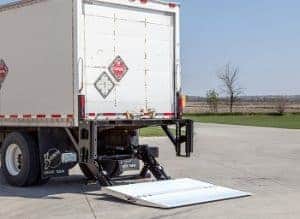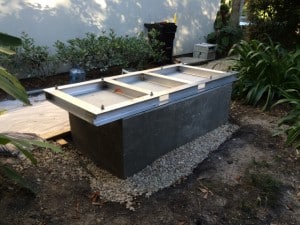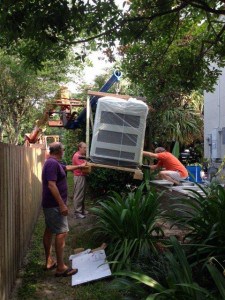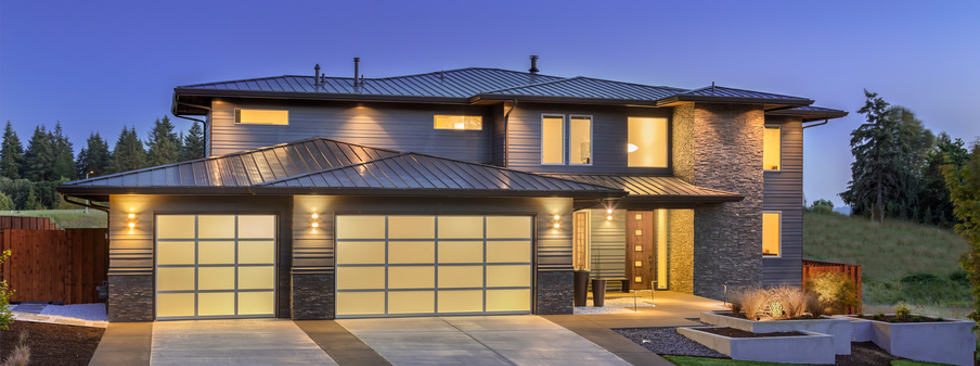What to Do When Your Home Backup Generator Delivery Truck Arrives
The last time the power went out, you promised to do something about it before it happened again. You made the decision, and took action by ordering a new standby generator from Norwall Power Systems. What happens next?
Before the generator arrives, decide where it will wait until the installer arrives to put it in place and connect it to your home. You’ll need some help to move it after it arrives because the delivery driver probably won’t help much. Set up a tentative schedule with your installer and mention moving it. They may have a special cart.
Plan to be home when the delivery company arrives. They will not leave the generator unless you or someone you designated signs for it.
Buyer Guide: What Size Home Backup Generator Do I Need
Lift Gate Delivery Service

Lift Gate Service specifies a truck with a mechanical gate to lift or lower cargo. Photo – Jayhawk84
Norwall includes lift-gate delivery service with every home backup generator delivery. The truck that delivers your generator will use a platform that raises or lowers heavy items onto or off of the truck. They call the platform a lift gate, and ordering that kind of service usually costs extra, but Norwall includes it free of charge with every home backup generator order.
The delivery company will call to notify you that they have your generator ready for delivery. When they arrive, the truck stops at your driveway entrance to unload the standby generator. They won’t move it any further than that. Drivers have schedules to meet, and transport companies have liabilities to worry about. Even if you have a long driveway, curbside delivery means at the curb or entrance. Often this is close to your mailbox, but if you talk to the driver, they will probably set it down at your driveway entrance.
Don’t count on the driver to help you move the unit; You will need other arrangements for that.
How it Works—The Components of a Standby Generator
Inspect Before Accepting Delivery
Do Not Sign for Delivery of a Damaged Generator
You have every right to inspect the generator before you sign for it and should not sign if the generator is damaged.
If you, or the person you designate to accept delivery, has a good reason to believe the generator was damaged in shipment, refuse delivery. As stated in Norwall’s Terms and Conditions, if you sign for the delivery and the generator is damaged, responsibility for the damaged generator is entirely yours.
Describe the damage on the delivery receipt—Do Not Sign the receipt—and tell the driver to return it to the shipper. Document damage with pictures on your cell phone. Then call Norwall PowerSystems Immediately at 928-453-4494, and we will confirm that the trucking company did not make the delivery to you and ship a replacement as soon as possible
Suspect Shipping Damage? Don’t Sign. Here’s How to Tell
Moving Your New Home Backup Generator
Unless you happen to own a truck with a crane on it, you’re going to need some help. Home Standby Generators are heavy, and air-cooled units can ship weighing more than 500 pounds. Most standby generators have carry holes that allow you to insert two lengths of iron pipe through them to allow four or more people to carry the unit. Six or eight is probably better than four, but it might be difficult to find four strong people with good backs.
Other options include a truck with a crane on the back or some other mechanical means to lift and move heavy objects. Get the generator off your driveway entrance and move it near the final installation location. Protect the generator with a tarp until installation.
Tips on Moving Your Home New Generator for Installation
Site Selection and Preparation

Concrete Pads Prevent Generators from Sinking Into Soft Soil. Custom Pedestals Raise Generators Above Flood Waters.
You should already have spoken to your homeowner association and the local building code enforcement department about your installation requirements and understand their rules. The local building code department is usually the Authority Having Jurisdiction and their rules regarding placement may conflict with manufacturer requirements. The AHJ always takes precedence over minimum manufacturer requirements. Obtain assurance in writing that they will issue a building permit or have the permit before you order the generator.
Ideally, choose a site close to the electric utility meter and transfer switch which is the utility service entrance for your home. Other placement options are less than ideal and may add to the cost of the installation. Horizontal clearance includes 36 inches in front and on either side of the generator. Check the installation manual for minimum distance to the home siding, then check your building code rules. Have the installation manual in hand while speaking to the inspector about your installation so you can point out what the manufacturer requires if there is a conflict. Inspectors are sometimes flexible if there is a good reason and won’t compromise safety.
No windows, doors or vents within five feet horizontally of either generator end. There must be 60 inches between the top of the generator and the eaves of the home. Don’t install where water accumulates, comes off the roof, or otherwise affects the generator. Plan on a windbreak to keep leaves and other flammables or blowing snow from accumulating next to or on the generator.
Gravel beds start with a five-inch-deep rectangle dugout that is six inches longer and wider than the standby generator footprint. Cover the soil with weed-blocking landscape cloth and fill with pea gravel or crushed stone. Level the filler and compact it. Instead of stone, a concrete pad at least four inches deep is also a good installation base. Again, check your local codes for requirements. Some jurisdictions require concrete pads. Some installers require them as part of the installation cost.
DIY Installation Guide: Home Standby Generator for Emergency Power
Installation

Installation by Licensed and Insured Professionals Ensures the Job is Done Right and Meets Local Building Codes.
The building’s natural gas or LP gas supply will require an extension to the installation site, and some natural gas meters will require an upgrade. Installation involves some fairly extensive wiring for the transfer switch and generator, and plumbing gas lines requires another skill set. Unless you’re a qualified DIY plumber and electrician, installation is a job for an experienced professional.
If you plan to do the job yourself, your building inspector will want assurance that you know what you’re doing―plan to answer questions and submit a detailed installation plan before they issue your permit.
Bypassing the permit process opens you to liability and may void your homeowner insurance policy. While going through the permit process is not always the easiest or fastest way of getting things done, it is usually the safest and only way to ensure you won’t end up liable if someone is hurt or injured, or your home burns to the ground because of faulty wiring.
Ordering a standby generator is just the beginning. Getting it from the curb to your home and then having it installed is the real work. Do your homework, be prepared, and the entire process will happen smoothly.



















